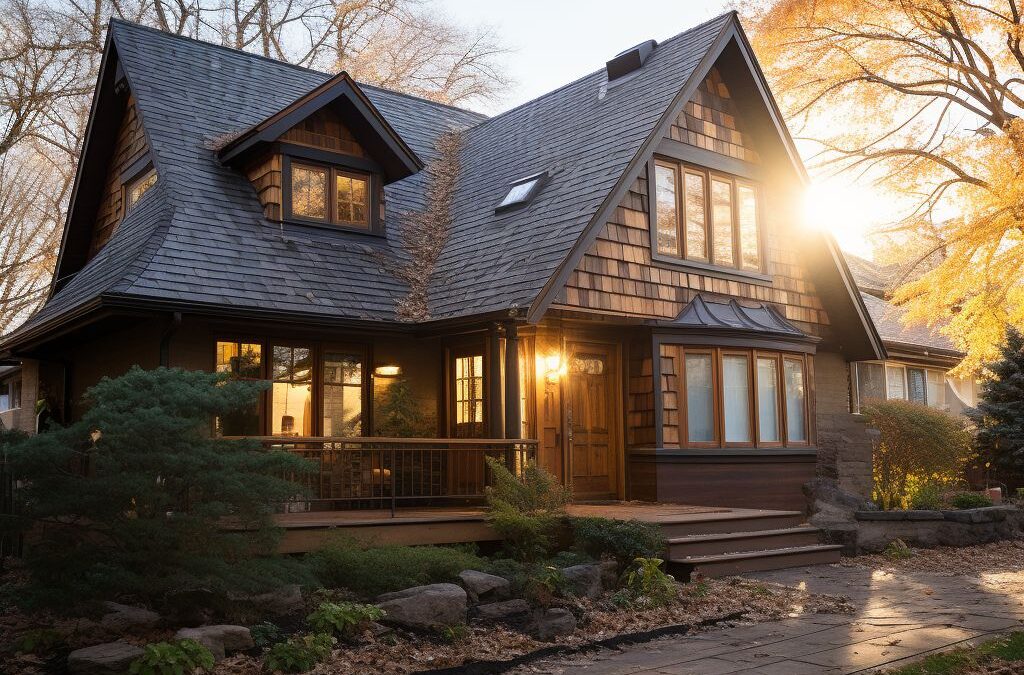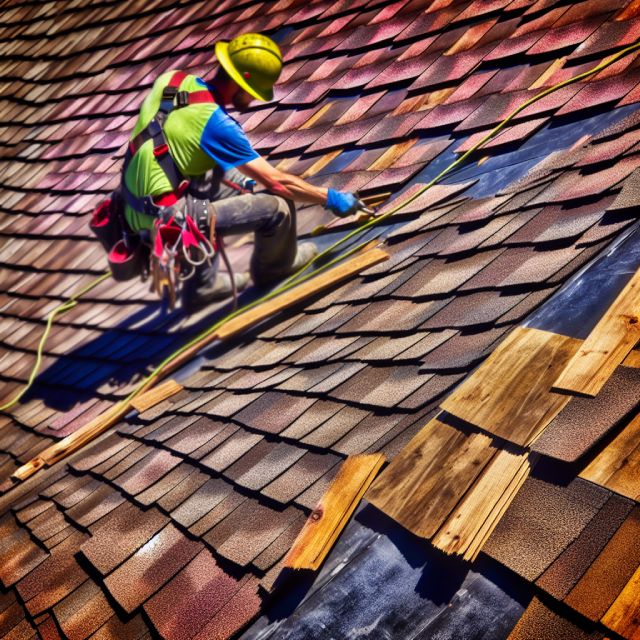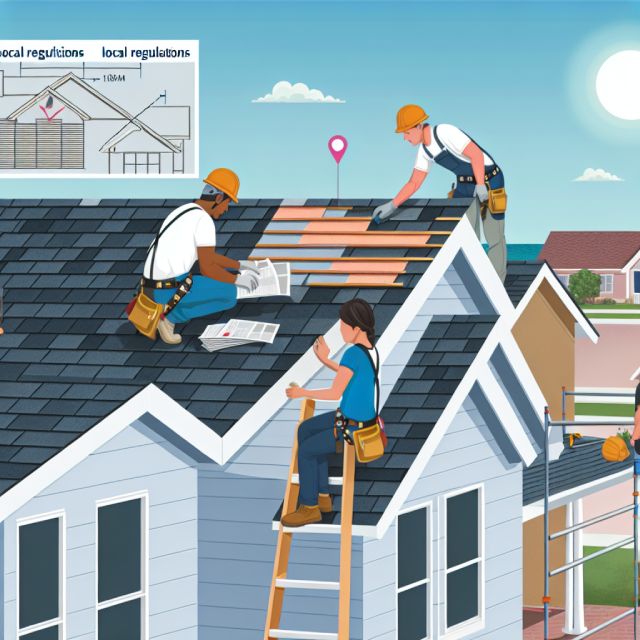Replacing roof shingles in Fresno, California may seem like a simple task to enhance your home, but did you know that it could potentially require you to obtain a permit?
Yes, you read that correctly.
While replacing shingles may not be as major as a full roof replacement, certain jurisdictions have regulations in place that mandate homeowners to seek the necessary permissions before starting this seemingly innocuous renovation.
So, before you climb up that ladder and start hammering away, let’s delve into the world of permits and find out if you need one to replace your roof shingles.
When Should You Obtain a Permit for Replacing Roof Shingles?
Replacing roof shingles is a common home improvement project that many homeowners undertake. However, before you dive into this task, it’s essential to understand when obtaining a permit is necessary.
Building permits play a crucial role in ensuring that roof shingle replacement meets local regulations and safety standards. While not all areas require permits for this type of project, it’s important to check with your local building department to determine if one is needed.
One factor that influences whether you need a permit for replacing roof shingles is the extent of the work being done. In general, minor repairs such as replacing a few damaged shingles may not require a permit.
However, if you are planning a full roof replacement or making significant modifications to your roof’s structure, a permit is likely necessary. Additionally, some areas may have specific regulations regarding roof shingle replacement, especially if you live in a historic district or a designated architectural zone.
Obtaining a permit is not just a legal requirement; it also ensures that the replacement work is done correctly and meets safety standards. When you obtain a permit, a building inspector will review the project to ensure it complies with local regulations. This inspection helps identify any potential issues or hazards that may arise from improper installation.
By obtaining a permit, you are investing in the long-term integrity and durability of your roof, protecting your investment, and safeguarding the occupants of your home.
Remember, failing to obtain a permit when required can result in penalties and fines, not to mention potential complications when selling your home. It’s always best to err on the side of caution and consult with your local building department to determine if you need a permit for your roof shingle replacement project.
Taking the time to follow the correct procedures and obtain the necessary permits will give you peace of mind and ensure that your roof replacement is completed smoothly and in compliance with local regulations.
Understanding the Role of Building Permits in Roof Shingle Replacement
Replacing roof shingles may seem like a simple task, but it’s essential to understand the role of building permits in this process. Building permits serve as a crucial regulatory mechanism to ensure that construction or renovation projects adhere to local building codes and regulations.
While the requirements for obtaining a permit may vary depending on your location, it’s important to familiarize yourself with the local guidelines before beginning any roof shingle replacement project.
Building permits are typically required for projects that involve structural changes or alterations to a property. In the case of roof shingle replacement, a permit may be necessary if the project involves more than just cosmetic changes.
This includes situations where decking or sheathing needs to be repaired or replaced, or if the roof must be stripped down to the bare frame before installing new shingles.
Additionally, if your roof is part of a historical or landmarked building, there may be additional regulations and permits required to ensure the preservation of the structure’s architectural integrity.
Obtaining a building permit for roof shingle replacement is essential for several reasons. Firstly, it ensures that the work is done correctly and in compliance with the local building codes. This helps to maintain the structural integrity of your roof, preventing potential issues such as leaks, moisture damage, or collapsed sections.
Secondly, having a permit provides legal protection for both homeowners and contractors.
If any issues arise during or after the project, having obtained the necessary permits demonstrates that the work was completed according to regulations. It also ensures that the homeowner is not liable for any penalties or fines resulting from non-compliance.
It’s important to note that the permit application process may vary depending on your location. Generally, it involves submitting detailed plans and specifications of the roof shingle replacement project to your local building department. This may include information about the type of shingles to be used, the method of installation, and any changes to the underlying structure. The building department will review the application and determine whether it meets the necessary requirements.
Once approved, you will receive the permit, which typically needs to be displayed prominently at the work site.
In conclusion, obtaining a building permit is crucial for any homeowner or contractor undertaking such a project. Building permits serve to ensure compliance with local regulations and building codes, ensuring the safety and integrity of your roof. By obtaining the necessary permits and following the proper procedures, you can ensure a smooth and successful roof shingle replacement project.
The Importance of Compliance: Local Regulations and Roof Shingle Replacement
When it comes to replacing roof shingles, it is essential to understand and comply with the local regulations governing such projects. These regulations vary from one jurisdiction to another, and failure to comply can lead to serious consequences.
It is crucial to be aware of the legal requirements in your area and ensure that you obtain any necessary permits before embarking on a roof shingle replacement project.ingle replacement project in Fresno, California.
Local regulations regarding roof shingle replacement are put in place for a reason. They are designed to ensure that all construction and renovation projects meet certain safety standards and adhere to building codes. By obtaining the required permits, homeowners can have peace of mind knowing that their roof replacement project is in compliance with these standards.
Failure to comply with local regulations can result in fines, penalties, and even the need to redo the entire project.
In addition to the financial implications, non-compliance can also lead to more serious consequences, such as insurance issues or invalidated warranties. It is always better to be safe than sorry when it comes to roof shingle replacement, and that means understanding and following the local regulations.
Before beginning any roof shingle replacement project, it is important to research and familiarize yourself with the specific regulations in your area. This information can typically be found on the website of your local building department or by contacting the appropriate authorities directly.
Pay close attention to any permit requirements, inspections that may be necessary, and any specific guidelines for the materials or methods used in the replacement process.
By prioritizing compliance with local regulations, homeowners can ensure that their roof shingle replacement project is completed safely and in accordance with the law. Taking the time to understand and adhere to these regulations demonstrates a commitment to quality workmanship and can help avoid any potential legal or financial issues down the line.
Remember, it is always better to be proactive and in compliance than to face the consequences of non-compliance.
Factors to Consider Before Beginning Roof Shingle Replacement Without a Permit
Before embarking on a roof shingle replacement project without obtaining a permit, there are several factors that homeowners should carefully consider. While the idea of bypassing the permit process may seem appealing in terms of time and cost savings, it is important to evaluate the potential risks and consequences.
- Firstly, it is essential to understand that building permits exist for a reason. They serve as a safeguard to ensure that any construction or renovation work adheres to local building codes and regulations. In the case of roof shingle replacement, a permit guarantees that the project meets safety standards and is carried out by qualified professionals. Without a permit, the homeowner assumes full responsibility for any potential damages or safety hazards resulting from the work.
- Additionally, undertaking roof shingle replacement without a permit might violate local regulations and building ordinances. Each municipality has its own set of rules regarding home improvement projects, and failure to comply can lead to costly penalties and legal complications. It is crucial to research and understand the specific requirements of your local jurisdiction before proceeding without a permit.
- Moreover, proceeding without a permit may also impact future insurance claims or property transfers. In the event of a roof-related incident, insurance companies may deny coverage if the replacement work was done without the necessary permits.
- Similarly, when selling a property, potential buyers may request documentation of any major renovations, including permits for roof shingle replacements. The absence of permits could raise red flags and potentially affect property value or hinder the sale process.
Considering the potential risks and implications, it is advisable to carefully weigh the decision to replace roof shingles without obtaining a permit. While it may seem like a shortcut, the long-term consequences may far outweigh any initial time or cost savings. Homeowners should prioritize compliance with local regulations and building codes to ensure a safe and legally compliant roof replacement project.
Navigating the Permit Application Process for Replacing Roof Shingles
Applying for a permit for roof shingle replacement can seem like a daunting task, but with some guidance, it can be a smooth process. Understanding and following the necessary steps will help ensure that your project is in compliance with local regulations and avoid any potential legal issues down the line.
First, it is crucial to research and familiarize yourself with your local building department’s requirements for obtaining a permit. Each jurisdiction may have specific rules and regulations, so it is important to be well-informed before beginning the application process. You can typically find this information on your city or county’s official website or by contacting the appropriate department directly.
Once you understand the requirements, gather all the necessary documentation and information needed for the permit application. This may include details such as the size of the roof, the type of shingles being used, and any additional materials or equipment being utilized during the replacement process. It is essential to provide accurate and complete information to avoid delays or potential rejections.
Next, fill out the application form with the required information. Be thorough and ensure that all sections are completed accurately. Most permitting processes will require you to submit detailed plans or drawings of your project, so be prepared to provide these if necessary. Additionally, you may need to include documentation such as proof of insurance or contractor licenses, depending on your local regulations.
Once your application is complete, submit it to the appropriate building department along with any required fees. Some jurisdictions may allow online submission, while others may require you to visit their office in person. Be sure to follow the specified submission instructions to avoid any unnecessary delays.
After submission, the building department will review your application to ensure compliance with local codes and regulations. This review process may take some time, so it is important to be patient. If any modifications or additional information is required, respond promptly and provide all the requested details.
Once your permit application is approved, you will receive the necessary documentation allowing you to proceed with your roof shingle replacement project. Make sure to keep these documents in a safe place as they may be required for future reference or inspections.
Remember, obtaining a permit for roof shingle replacement is essential to ensure compliance with local regulations and to protect yourself from potential legal issues. By navigating the permit application process correctly, you can proceed with your project confidently and enjoy a successful and problem-free roof shingle replacement.
Expert Tips for Smooth Permit Approval in Roof Shingle Replacement Projects
Obtaining a permit for replacing roof shingles can sometimes be a challenging task. However, there are certain expert tips that can increase your chances of smooth permit approval. These tips can help you navigate through the application process and ensure compliance with local regulations.
- Firstly, it is important to be thorough and accurate in your permit application. Provide all the necessary information and documentation required, and ensure that everything is completed correctly. This will help expedite the review process and increase your chances of approval.
- Additionally, it is recommended to communicate openly and effectively with the building department staff. If you have any questions or concerns about the application process, don’t hesitate to reach out for clarification. Building a positive relationship with the staff can help streamline the process and ensure a smoother approval.
- Lastly, it is crucial to follow up on your application and respond promptly to any requests for additional information. Stay organized and keep track of all communication and documentation related to your permit application. By being proactive and responsive, you can demonstrate your commitment to compliance and increase your chances of a successful permit approval.
By following these expert tips and guidelines, homeowners in Fresno, California can navigate the permit application process for roof shingle replacement projects with confidence and ensure a smooth and legally compliant project completion.
In Fresno, California, it is crucial to familiarize yourself with the specific permit requirements in your area. Local regulations may vary, so it’s essential to research and understand the rules before submitting your application.
This includes knowing the necessary documents or drawings that need to be included, as well as any fees that may be involved. By being well-prepared, you can avoid unnecessary delays and setbacks in the permit approval process.
Another expert tip is to create a detailed and comprehensive project plan. This plan should include all the necessary information about the roof shingle replacement, such as the type and brand of shingles to be used, the estimated timeline for the project, and the qualifications or certifications of the contractor involved. Providing this information upfront demonstrates your commitment to complying with regulations and ensures that the permit reviewer has all the necessary information to make an informed decision.
Additionally, it is advisable to communicate and collaborate with your local building department throughout the permit application process. This can help streamline the approval process and address any concerns or questions that may arise. Building inspectors are often willing to provide guidance and assistance to ensure that your project meets all the necessary requirements.
Lastly, it is important to be patient and proactive during the permit approval process. Permit applications can sometimes take time, so it’s essential to plan your project timeline accordingly. Proactively following up with the building department and addressing any additional requirements or concerns promptly can help expedite the approval process.
Obtaining a permit for replacing roof shingles is an important step in ensuring compliance with local regulations and avoiding potential legal issues. By following these expert tips, you can increase your chances of smooth permit approval, allowing you to commence your roof shingle replacement project without any unnecessary delays or complications. Remember, it’s always better to be proactive and prepared when it comes to obtaining permits for construction projects.
Final Words
In conclusion, the need for a permit to replace roof shingles varies depending on local regulations and the extent of the work being done. It is important to check with your local building department or municipality to determine the specific requirements for your area.
While some jurisdictions may require a permit for any roofing work, others may only require it for more extensive projects such as replacing the entire roof or adding new structures. Obtaining a permit ensures that the work is done in compliance with local building codes and regulations, which is important for the safety and structural integrity of your home.
Even if a permit is not required, it is still recommended to hire a professional roofing contractor who is licensed and insured. They will have the necessary expertise to properly install the shingles and ensure that they are done correctly.
By following the local regulations and hiring a qualified professional, you can ensure that your roof replacement is done safely and in compliance with the necessary standards. This will not only protect your home and its occupants but also potentially increase the value of your property.
Remember to always consult with your local authorities and professionals in your area to ensure you are following the appropriate guidelines and regulations when replacing roof shingles.

Emergency Services Manager
Andrew Foster, a seasoned roofing professional, specializes in storm damage repairs and emergency services. His swift response and effective solutions help clients safeguard their properties during challenging times.



